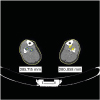1. Jain P, Ward E, Nevatte T, Roffe C. Incidence of venous thromboembolism in the wake of the Clots in Legs Or sTockings after Stroke (CLOTS) study. Stroke. 2013; 44:2910–2912.
2. Kyrle PA, Eichinger S. Deep vein thrombosis. Lancet. 2005; 365:1163–1174.
3. Pambianco G, Orchard T, Landau P. Deep vein thrombosis: prevention in stroke patients during rehabilitation. Arch Phys Med Rehabil. 1995; 76:324–330.
4. Heit JA, Silverstein MD, Mohr DN, Petterson TM, O'Fallon WM, Melton LJ 3rd. Risk factors for deep vein thrombosis and pulmonary embolism: a population-based case-control study. Arch Intern Med. 2000; 160:809–815.
5. Goldhaber SZ, Bounameaux H. Pulmonary embolism and deep vein thrombosis. Lancet. 2012; 379:1835–1846.
6. Wells P, Anderson D. The diagnosis and treatment of venous thromboembolism. Hematology Am Soc Hematol Educ Program. 2013; 2013:457–463.
7. Aquila AM. Deep venous thrombosis. J Cardiovasc Nurs. 2001; 15:25–44.
8. Hong MY, Lee C, Yoo SY, Shin DH, Cheong SS, Kwon JH, et al. Cut-off value and factors associated with a false positive D-dimer result for venous thromboembolism in Koreans. Korean J Med. 2013; 84:372–378.
9. Wells PS, Hirsh J, Anderson DR, Lensing AW, Foster G, Kearon C, et al. Accuracy of clinical assessment of deep-vein thrombosis. Lancet. 1995; 345:1326–1330.
10. Kabrhel C, Mark Courtney D, Camargo CA Jr, Plewa MC, Nordenholz KE, Moore CL, et al. Factors associated with positive D-dimer results in patients evaluated for pulmonary embolism. Acad Emerg Med. 2010; 17:589–597.
11. Haeger K, Sjukhuset A. Problems of acute deep venous thrombosis. I. The interpretation of signs and symptoms. Angiology. 1969; 20:219–223.
12. Cogo A, Lensing AW, Prandoni P, Hirsh J. Distribution of thrombosis in patients with symptomatic deep vein thrombosis. Implications for simplifying the diagnostic process with compression ultrasound. Arch Intern Med. 1993; 153:2777–2780.
13. Strandberg S, Lindström M, Wretling ML, Aspelin P, Shalabi A. Muscle morphometric effect of anterior cruciate ligament injury measured by computed tomography: aspects on using non-injured leg as control. BMC Musculoskelet Disord. 2013; 14:150.
14. Akman MN, Cetin N, Bayramoglu M, Isiklar I, Kilinc S. Value of the D-dimer test in diagnosing deep vein thrombosis in rehabilitation inpatients. Arch Phys Med Rehabil. 2004; 85:1091–1094.
15. Johanning JM, Franklin DP, Thomas DD, Elmore JR. D-dimer and calf circumference in the evaluation of outpatient deep venous thrombosis. J Vasc Surg. 2002; 36:877–880.
16. Hagan JE, Babcock HM, Kirmani N. Treatment of infectious diseases. In : Foster C, Mistry NF, Peddi PF, Sharma S, editors. The Washington manual of medical therapeutics. 33rd ed. Philadelphia, PA: Wolters Kluwer;2010. p. 440–510.
17. Hachisuka K, Umezu Y, Ogata H. Disuse muscle atrophy of lower limbs in hemiplegic patients. Arch Phys Med Rehabil. 1997; 78:13–18.
18. Powers SK, Kavazis AN, DeRuisseau KC. Mechanisms of disuse muscle atrophy: role of oxidative stress. Am J Physiol Regul Integr Comp Physiol. 2005; 288:R337–R344.
19. Urso ML. Disuse atrophy of human skeletal muscle: cell signaling and potential interventions. Med Sci Sports Exerc. 2009; 41:1860–1868.
20. Wall BT, Dirks ML, Snijders T, Stephens FB, Senden JM, Verscheijden ML, et al. Short-term muscle disuse atrophy is not associated with increased intramuscular lipid deposition or a decline in the maximal activity of key mitochondrial enzymes in young and older males. Exp Gerontol. 2015; 61:76–83.
21. Kuwashiro T, Toyoda K, Oyama N, Kawase K, Okazaki S, Nagano K, et al. High plasma D-dimer is a marker of deep vein thrombosis in acute stroke. J Stroke Cerebrovasc Dis. 2012; 21:205–209.
22. Erdman WA, Jayson HT, Redman HC, Miller GL, Parkey RW, Peshock RW. Deep venous thrombosis of extremities: role of MR imaging in the diagnosis. Radiology. 1990; 174:425–431.
23. Chang JH, Lee HJ, Kwon JH, Ryu GH, Moon H, Kim C, et al. Usefulness of the computed tomography venography for evaluation of leg edema including deep vein thrombosis in rehabilitation patients. Ann Rehabil Med. 2014; 38:812–820.
24. Moser KM, LeMoine JR. Is embolic risk conditioned by location of deep venous thrombosis? Ann Intern Med. 1981; 94:439–444.









 PDF
PDF Citation
Citation Print
Print



 XML Download
XML Download